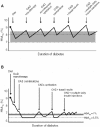Inhaled human insulin (Exubera): clinical profile and patient considerations
- PMID: 17583178
- PMCID: PMC1994047
Inhaled human insulin (Exubera): clinical profile and patient considerations
Abstract
Inhaled human insulin (Exubera) is a rapid-acting regular human insulin administered by oral inhalation before meals. It provides a non-invasive alternative to multiple subcutaneous injections for the treatment of hyperglycemia in adult patients with type 1 and type 2 diabetes. Compared with subcutaneous rapid-acting insulin analogs, Exubera provides equivalent HbA1c control. As a monotherapy or in combination with oral agents, Exubera also provides greater glycemic control than oral agents alone, at least in patients with high levels of HbA1c. Exubera demonstrates improved patient satisfaction compared with subcutaneous insulin or oral agents alone. When offered as a treatment option together with standard treatments in uncontrolled patients naive to insulin, Exubera increases acceptance of insulin therapy three-fold compared with patients offered standard regimens only. Exubera is well tolerated in comparison to subcutaneous insulin, with a similar incidence of mild to moderate hypoglycemia. Although cough is a common adverse effect early in therapy, this leads to treatment discontinuations in less than 1% of patients. Despite an increased incidence of insulin antibodies compared with subcutaneous administration, and a consistent but minor impact on pulmonary function, long-term safety data of up to 4 years continue to support the safety profile of Exubera.
Figures



Similar articles
-
Inhaled insulin: Exubera.Ann Pharmacother. 2005 May;39(5):843-53. doi: 10.1345/aph.1E522. Epub 2005 Apr 12. Ann Pharmacother. 2005. PMID: 15827072 Review.
-
Evolution of a pulmonary insulin delivery system (Exubera) for patients with diabetes.MedGenMed. 2007 Mar 5;9(1):45. MedGenMed. 2007. PMID: 17435648 Free PMC article. Review.
-
Randomized study to characterize glycemic control and short-term pulmonary function in patients with type 1 diabetes receiving inhaled human insulin (exubera).J Clin Endocrinol Metab. 2007 Jun;92(6):2211-4. doi: 10.1210/jc.2006-0631. Epub 2006 Sep 26. J Clin Endocrinol Metab. 2007. PMID: 17003088 Clinical Trial.
-
Exubera inhaled insulin in patients with type 1 and type 2 diabetes: the first 12 months.Diabetes Technol Ther. 2009 Jul;11(7):427-30. doi: 10.1089/dia.2008.0131. Diabetes Technol Ther. 2009. PMID: 19580355
-
Patient satisfaction and glycemic control after 1 year with inhaled insulin (Exubera) in patients with type 1 or type 2 diabetes.Diabetes Care. 2004 Jun;27(6):1318-23. doi: 10.2337/diacare.27.6.1318. Diabetes Care. 2004. PMID: 15161782
Cited by
-
Psychological insulin resistance: patient beliefs and implications for diabetes management.Qual Life Res. 2009 Feb;18(1):23-32. doi: 10.1007/s11136-008-9419-1. Epub 2008 Nov 28. Qual Life Res. 2009. PMID: 19039679
-
The Current and Promising Oral Delivery Methods for Protein- and Peptide-Based Drugs.Int J Mol Sci. 2024 Jan 9;25(2):815. doi: 10.3390/ijms25020815. Int J Mol Sci. 2024. PMID: 38255888 Free PMC article. Review.
References
-
- American Diabetes Association. Diabetes Care; Consensus Development Conference on the diagnosis of coronary heart disease in people with diabetes; 10-11 February 1998; Miami, Florida. 1998. pp. 1551–9. - PubMed
-
- Barnett AH, Dreyer M, Lange P, et al. An open, randomized, parallel group study to compare the efficacy and safety profile of inhaled human insulin (Exubera®) with metformin as adjunctive therapy in patients with type 2 diabetes poorly controlled on a sulfonylurea. Diabetes Care. 2006a;29:1282–7. - PubMed
-
- Barnett AH, Dreyer M, Lange P, et al. An open, randomized, parallel-group study to compare the efficacy and safety profile of inhaled human insulin (Exubera) with glibenclamide as adjunctive therapy in patients with type 2 diabetes poorly controlled on metformin. Diabetes Care. 2006;29:1818–25. - PubMed
-
- Becker RHA, Sha S, Frick AD, et al. The effect of smoking cessation and subsequent resumption on absorption of inhaled insulin. Diabetes Care. 2006;29:277–82. - PubMed
-
- Brown JB, Nichols GA. Slow response to loss of glycemic control in type 2 diabetes mellitus. Am J Manag Care. 2003;9:213–7. - PubMed
Publication types
MeSH terms
Substances
LinkOut - more resources
Full Text Sources
Medical
Research Materials

